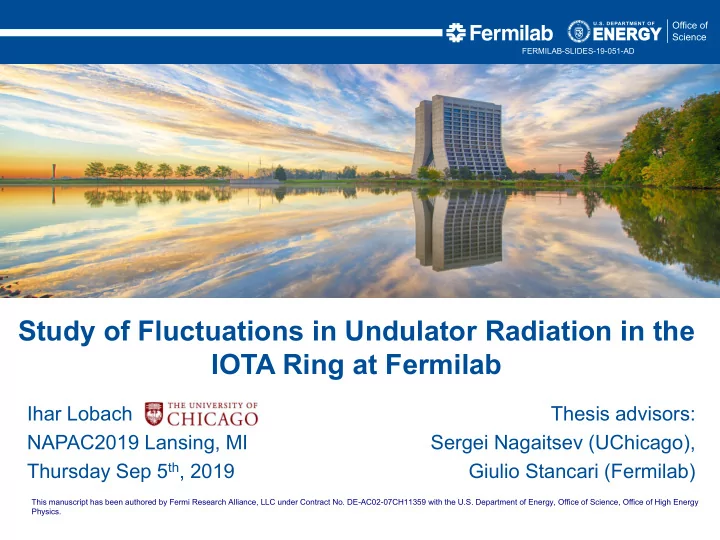

FERMILAB-SLIDES-19-051-AD Study of Fluctuations in Undulator Radiation in the IOTA Ring at Fermilab Ihar Lobach (UChicago) Thesis advisors: NAPAC2019 Lansing, MI Sergei Nagaitsev (UChicago), Thursday Sep 5 th , 2019 Giulio Stancari (Fermilab) This manuscript has been authored by Fermi Research Alliance, LLC under Contract No. DE-AC02-07CH11359 with the U.S. Department of Energy, Office of Science, Office of High Energy Physics.
Collaboration I. Lobach, UChicago, S. Nagaitsev, V. Lebedev, A. Romanov, A. Valishev, G. Stancari, Fermilab, A. Halavanau, Z. Huang, V. Yakimenko, SLAC, A. Murokh, Radiabeam, K. J. Kim, ANL, T. Shaftan, BNL Acknowledgments: We would like to thank the entire FAST/IOTA team for helping us with building and installing the setup, and taking measurements, especially Wayne Johnson, Mark Obrycki, and James Santucci; Greg Saewert, for constructing the photodetector circuit and providing the test light source; David Johnson and Todd Johnson, for kindly providing test equipment and assisting during tests of our detector. Numerous pieces of advice given by Daniil Frolov are greatly appreciated as well. A.H. is grateful to G. Stupakov and Y. Cai (SLAC) for many in-depth physics discussions on the subject. 2 9/5/2019 Ihar Lobach | NAPAC2019 Lancing, MI
Integrable Optics Test Accelerator (IOTA) • First beam Aug 21, 2018 Circumference: 40 m • Particles: electrons/protons Electron energy: 100 MeV • Main experiments: – Nonlinear beam optics Not a user facility! – Optical stochastic cooling 3 9/5/2019 Ihar Lobach | NAPAC2019 Lancing, MI
Experiment idea • We installed an undulator in the IOTA ring (late Feb). • And built an integrating circuit for the photodiode’s current. The amplitude of the output voltage was proportional to the number of photoelectrons generated in the photodiode. • In the experiment (late Mar), we study the fluctuation in the number of photoelectrons, namely, the variance: 4 9/5/2019 Ihar Lobach | NAPAC2019 Lancing, MI
Theoretical prediction Page 28: Discrete quantum Chaotic light. Incoherent nature of light sum over randomly phased electrons In our experiment: #1 Wide band, large solid angle, high QE=80% #2 The two terms are comparable RMS fluctuation ∼ 10 −4 − 10 −3 #3 5 9/5/2019 Ihar Lobach | NAPAC2019 Lancing, MI
More details on the setup. The photodiode detector G11193-10R 1077 nm *we did not check these data for QE 6 9/5/2019 Ihar Lobach | NAPAC2019 Lancing, MI
Comb filter. Testing the setup Crosstalk: 0.7% 7 9/5/2019 Ihar Lobach | NAPAC2019 Lancing, MI
Noise subtraction algorithm • In the real experiment with undulator radiation signal/noise<1: Main sources of noise: • The oscilloscope 1mV peak-to-peak • The integrator’s op-amp 1.5mV peak-to-peak (together with the scope) Total RMS noise: ≈ 0.3 mV 8 9/5/2019 Ihar Lobach | NAPAC2019 Lancing, MI
Testing the setup. Finding its precision Detector test idea: Keep the test light source in the same regime and use different ND filters. Relative classical fluctuation (due to pulse generator and amplifier errors) must stay the same: • 𝜄 is determined at large 𝒪 , when signal/noise ≫ 1 . • Poisson contribution is negligible. Determined error bar = 2.5 × 10 6 9 9/5/2019 Ihar Lobach | NAPAC2019 Lancing, MI
Measurement results in IOTA • Constant number of electrons in the bunch, different neutral density (ND) filters in front of the detector Decreasing optical density of the filters 10 9/5/2019 Ihar Lobach | NAPAC2019 Lancing, MI
Measurement results in IOTA • Changing the electron bunch charge. No neutral density (ND) filters in front of the detector. Model for bunch dimensions: • Longitudinal size is constant, measured with a wall-current monitor • Vertical size is constant and determined by multiple scat- tering on the background gas • Horizontal size and momen- tum spread are determined by intrabeam scattering* Measurement of 𝜗 𝑧 /𝜗 𝑦 @1.3mA: Increasing charge of the electron bunch *S. Nagaitsev, Phys. Rev. ST Accel. Beams 8.6 (2005): 064403. 11 9/5/2019 Ihar Lobach | NAPAC2019 Lancing, MI
Conclusions • Quantitative theoretical model for the experiment from [1] was developed and verified in an independent experiment in IOTA • It helped corroborate a model of intrabeam scattering in IOTA. The agreement is expected to improve in the future. • It was shown that along with measurements of longitudinal bunch size [2-5] the fluctuations can be used to measure transverse bunch size in some cases (e.g., in IOTA). I. Lobach, V. Lebedev, S. Nagaitsev, A. Romanov, G. Stancari, A. Halavanau, Z. Huang, and K.-J. Kim, Intensity fluctuations in undulator radiation , will be submitted to PRAB. Improvements as compared to the similar experiment from [1]: • Better precision due to using the comb filter with one-turn delay and the special noise subtraction algorithm. In IOTA, fluctuations were two orders of magnitude smaller than in [1]. • Fluctuations data were collected for different values of bunch charge. • The transition from Poisson statistics to Super-Poisson statistics was observed in undulator radiation for the first time. 12 9/5/2019 Ihar Lobach | NAPAC2019 Lancing, MI
Thank you for your attention! Ihar Lobach | NAPAC2019 Lancing, MI
Recommend
More recommend